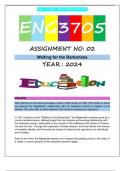LOLA JACOBS ASSIGNMENTS © 2024
ENG3705
ASSIGNMENT NO: 02
Waiting for the Barbarians
YEAR : 2024
PREVIEW:
With reference to the above passages, write a critical essay of 1200-1500 words in which
you discuss the Magistrate’s relationship with the barbarian woman in relation to his
dreams. You may refer to other dreams in the novel to support your argument.
In J.M. Coetzee's novel "Waiting for the Barbarians," the Magistrate's dreams serve as a
crucial narrative device, offering insight into his complex and evolving relationship with
the barbarian woman, particularly in the context of her suffering at the hands of Colonel
Joll and his men. Through the exploration of these dreams, the novel delves into themes
of empathy, identity, and the profound impact of violence and oppression on individuals
and societies.
Early in the novel, the Magistrate dreams of a hooded child patting snow on the sides of
a castle, a scene symbolic of the barbarian woman's plight…
, LOLA JACOBS ASSIGNMENTS © 2024
Assignment 2
ENG3705
Semester 1
Additional activities:
Complete the following activities to earn 5% extra on your assignment mark. Please note
that AI generated activities will not receive any marks.
1. Page through the novel and make a list summarising all the Magistrate’s dreams
(include page numbers).
2. What role do you think dreams play in the novel?
3. Why do you think dreams can be an important creative tool used in writing?
4. Think about the Magistrate’s relationship with the barbarian woman. Do you think
it was positive for her, or not? Briefly explain your reasoning.
5. How does the Magistrate feel about Colonel Joll’s treatment of the barbarian
woman? Explain your answer briefly.
Assignment
Waiting for the Barbarians by J.M. Coetzee
The Magistrate has several dreams in the novel, many of them of children, and, in
particular, a young child who seems to represent the barbarian woman tortured by Colonel
Joll and his men:
Only one figure remains, a hooded child sitting with its back to me. I circle around
the child, who continues to pat snow on the sides of the castle, till I can peer under
the hood. The face I see is blank, featureless; it is the face of an embryo or a tiny
whale; it is not a face at all but another part of the human body that bulges under
the skin; it is white; it is the snow itself (Coetzee, 1980: 37).
I fear, at this last instant, that she will be a disappointment, that the face she will
present to me will be obtuse, slick, like an internal organ not meant to live in the
light. But no, she is herself, herself as I have never seen her, a smiling child, the
light sparkling on her teeth and glancing from her jet-black eyes. "So this is what it
is to see!" I say to myself. I want to speak to her through my clumsy frozen muzzle.
"How do you do all that fine work with your hands in mittens?" I want to say. She
smiles kindly on my mumbling. Then she turns back to her fort in the snow.
(Coetzee, 1980: 72)




